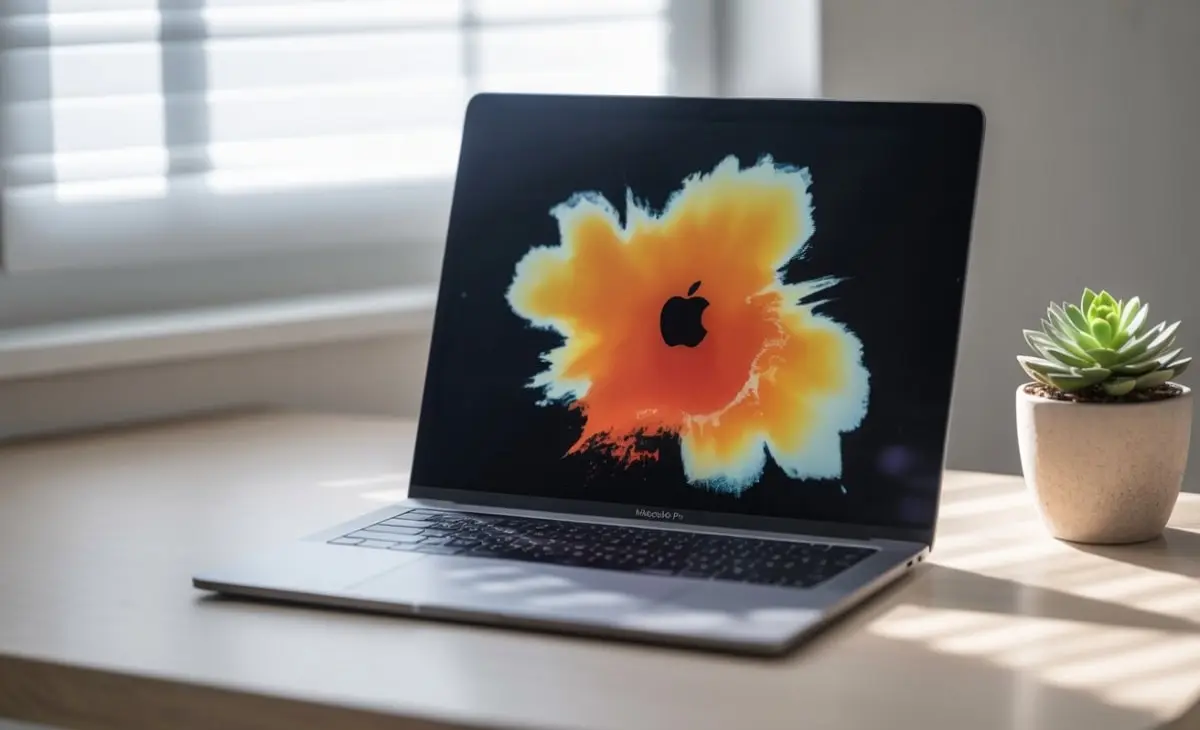If you have noticed orange discolouration on your MacBook Pro, you are not alone. This issue may come as a surprise, especially if you’ve spent a lot of money on a fancy, expensive device. Many users start to worry: is it rust, heat damage, or something else? This orange tint can actually be caused by a variety of factors, some of which are benign and others of which may call for medical attention.
We’ll examine the causes of the orange discolouration on the MacBook Pro, how to identify the source, and workable fixes. Whether it’s the screen, keyboard, or case, this post will help you bring your MacBook back to its former splendour.
What Is the Orange Discolouration on a MacBook Pro?
The phrase “orange discolouration” typically refers to a discernible orange or rust-coloured tint on certain parts of the MacBook Pro, usually the aluminium body, screen corners, keyboard edges, or ports. Environmental influences, material reactions, and even usage patterns can all play a role.
This discolouration can appear as a mild hue, stain, or spot that is difficult to remove with simple washing. Knowing why it happens is the first step towards a successful solution.
Possible reasons for orange discoloration on a MacBook Pro
The oxidation of the aluminium body
Even though MacBook Pros are made of high-quality aluminium, this durable metal can oxidise over time. When exposed to moisture, humidity, or acidic substances, the metal may take on a subtle orange or bronze colour.
Why it happens: When aluminium reacts with oxygen or certain impurities, aluminium oxide is produced, which can occasionally have an orange or rust-like appearance.
It typically appears adjacent to ports, edges, or palm rests.
Heat Exposure or Overheating
Clogged air vents or excessive heat from prolonged use can cause discolouration. Excessive heat can slightly alter the colour of your MacBook’s casing or screen tint.

Why it happens: The anodised aluminium surface or screen backlight may change colour due to heat stress.
It is located around the keyboard, near the power button, or on the screen bezel
Sweat and Oils on the Skin
Human sweat contains acids and salts that aluminium can react with. If you frequently use the MacBook Pro in humid conditions or without washing your hands, it may eventually turn orange.
Why it happens: Orange or brownish stains are the result of surface microreactions brought on by acids and oils.
It is located on the palm rests, trackpad edges, and adjacent to the keyboard.
Liquid and Debris Spills
Spills of soda, juice, or coffee, no matter how small, can seep into cracks or leave stains on the body of your MacBook. When the liquid dries, it might leave an orange or yellowish residue behind.
Why it happens: The pigments and sugars in food and beverages are what cause surface discolouration.
It is located in the keyboard, USB ports, or touch bar area.
Display Color Tint or Image Retention
If the discolouration appears on the display itself rather than the body, it may be due to issues with screen tint or burn-in, or pixel ageing. Older MacBook Pro models with LCD or Retina screens may begin to turn a warm orange over time.
Why it happens: The display’s colour balance may be altered by prolonged exposure to static images or uneven pixel deterioration.
Where it appears: The entire display or the corners of the screen.
How to Find the Source of My MacBook Pro’s Orange Discolouration
Prior to trying any fixes, it is essential to identify the cause of the problem.
- Take a close look at the surface: Use a soft light to see if the discolouration is on the outside or beneath a protective layer.
- Look at the screen on your own: A white background will appear when the screen first opens. If the tint appears only when the device is powered on, it’s most likely a display issue.
- Clean a small area: Apply a gentle cleaning method to a small area to see if it disappears.
- Be mindful of environmental factors: If you work near heat sources or in a humid environment, oxidation or heat tint may be the cause.
You can move on to the best solution once you have identified the cause.
Solutions That Are Effective for Orange Discolouration
Make use of isopropyl alcohol and a microfiber cloth.
To clean your MacBook Pro, use a microfiber cloth and isopropyl alcohol.
For surface stains, a microfiber cloth dampened with 70% isopropyl alcohol for a short time is your best friend. Use gentle circular motions to wipe the affected area. Avoid applying too much pressure.

Steps to take:
- Turn off your MacBook and unplug it.
- Avoid putting alcohol directly on the device; instead, dab a few drops onto a towel.
- Gently wipe the orange areas.
- Let it air dry completely.
Perfect for: Sweat stains, mild oxidation, and surface discolouration.
Use a Gentle Aluminum Cleaning Solution
To get rid of body stains, try using a mild aluminium cleaner.
If alcohol doesn’t work, a non-abrasive aluminium cleaner can help restore the metal finish. Since these products are designed for anodised surfaces, they won’t scratch the MacBook’s body.
Steps to take:
- Apply a tiny bit to a soft cloth.
- You should gently rub the discoloured area.
- Wipe clean with a dry cloth.
Caution: Always test it first on a small, discrete area to avoid altering the texture.
Resolve Overheating Issues
If the tint is caused by your MacBook Pro overheating, focus on cooling it instead of cleaning.
Suggestion:
- Avoid using it on delicate surfaces, such as beds or couches.
- Verify that the air vents are unobstructed.
- Use a cooling pad or external fan.
- Regularly use compressed air to clean the fans of dust.
Lowering the temperature will prevent further discolouration and may even somewhat lessen stains that are already present.
Wipe the Display Carefully
Avoid using harsh chemicals if your screen starts to discolour. Instead, use distilled water or a microfiber cloth and a screen-safe cleaner.
Steps to Take:
- Disconnect and turn off your MacBook.
- Wipe with gentle circular motions.
- Don’t press too hard to prevent pixel damage.
If the orange tint persists, it may be due to ageing or display calibration issues.
Adjust the Display Calibration
When the orange colour is visible on the screen, recalibration may be helpful.
Steps to take:
- Go to System Settings > Displays > Colour.
- Choose Calibrate Display or manually adjust the colour temperature.
- Make adjustments to the white point and colour balance to eliminate the orange tint.
This is particularly useful for older Retina MacBook Pros that inherently produce warmer tones.
Consider Replacing the Screen or Top Case if Needed
If the discolouration is severe—due to deep oxidation, heat burn, or liquid damage, for example—replacement may be the only long-term remedy.
Top case replacement:
- For obstinate body discolouration.
- The screen should be replaced if the tint is permanent and prevents the screen from being used.
It is best to have this done at an authorised Apple repair facility in order to ensure quality and maintain warranty protection.
Ways to Prevent Orange Discolouration MacBook Pro
An ounce of prevention is worth a pound of cure. The following advice will help you keep your MacBook in good condition for many years to come:
- Use a protective case or skin to shield yourself from spills and perspiration.
- Keep your workspace neat and dry.
- Strong cleansers or abrasive materials shouldn’t come into contact with the aluminium body.
- Store your MacBook somewhere cool and dry when not in use.
- Use a microfiber cloth to clean your device frequently to prevent accumulation.
- You can preserve the recognisable silver finish of your MacBook Pro by following these tips.
When to Consult a Professional Technician
If your efforts prove fruitless or the discolouration worsens, consult a trained technician. Repair shops authorised by Apple can identify whether the issue is cosmetic, hardware-related, or pertains to the display assembly itself.
Seek professional help if:
- The discolouration affects the display’s quality.
- It is accompanied by strange sounds or heats.
- The aluminium has a rough, rusted feel to it.
Final Thoughts
The Orange Discolouration MacBook Pro is generally manageable despite its frightening appearance. Both the causes and the remedies vary, ranging from heat exposure and surface oxidation to screen tints. Whether you’re cleaning the body, adjusting the screen, or addressing overheating, a little care can go a long way towards restoring your MacBook’s sleek appearance.
With routine maintenance and preventative care, you can keep your device operating and looking like new for many years. Remember that it’s more than just a computer—it’s an investment worth protecting.
Check Also:https://coruzants.com/blog/gramhir-pro/
